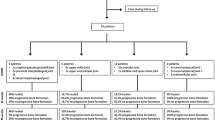Abstract
The application of extracorporeal shock waves has become a new mode of treatment for affections of the locomotor apparatus such as calcifying tendinitis, epicondylitis humeri radialis, calcaneodynia and pseudarthrosis. The treatment often takes place in the vicinity of joints. Up to now no systematic data have been published about possible side-effects on joint cartilage. In an in vivo study the effect of extracorporeal shock waves on joint cartilage was evaluated in 24 immature New Zealand White rabbits. The left lateral femoral condyle of each animal was treated with 2000 shock waves of 1.2 mJ/mm2; the right condyle served as control. Macroscopical, radiological and histological analysis at 0, 3, 12 and 24 weeks after treatment showed no pathological changes in the joint cartilage. We conclude that extracoporeal shock wave treatment does not cause damage to the joint cartilage of growing rabbits.
Similar content being viewed by others
Author information
Authors and Affiliations
Additional information
Received: 9 August 1999
Rights and permissions
About this article
Cite this article
Väterlein, N., Lüssenhop, S., Hahn, M. et al. The effect of extracorporeal shock waves on joint cartilage – an in vivo study in rabbits. Arch Orth Traum Surg 120, 403–406 (2000). https://doi.org/10.1007/PL00013770
Issue Date:
DOI: https://doi.org/10.1007/PL00013770




